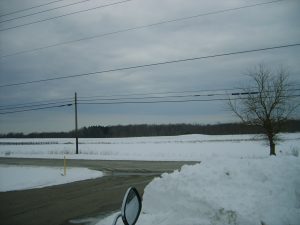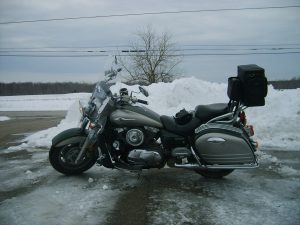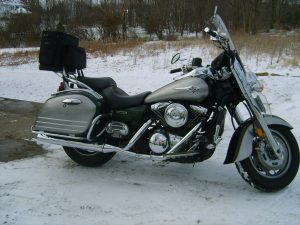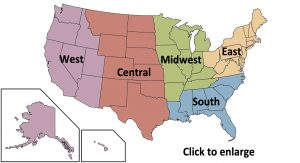


State Watch

Information for State Watch is from the AMA
California
Senate Resolution 63, introduced by state Sen. Anna Caballero promotes increased public awareness on the issue of motorcycle profiling. The resolution also encourages collaboration and communication between the motorcycle community and local and state law enforcement agencies to engage in efforts to end motorcyclist profiling. It also urges state law enforcement officials to include statements condemning motorcyclist profiling in policies training materials.
Wisconsin
ABATE of Wisconsin reports that two state senators are circulating a draft bill that would allow retailers to dispense all blends of fuel through one pump nozzle. The bill (LRB2170/P1) would apply to fuel blends up to 15 percent ethanol (E15). The AMA joins ABATE of Wisconsin in opposing this bill, which would dramatically increase the likelihood of inadvertent misfueling by motorcyclists. No motorcycles or ATV’s sold in the United States are certified by the EPA to operate on fuel containing more than 10 percent ethanol (E10).
Georgia
The Department of Driver Services Georgia Motorcycle Safety Program received a $83,464 grant from the Governor’s Office of Highway Safety to help reduce motorcycle fatalities, increase driver awareness of motorcycles and educate motorcycle riders about safety initiatives. The grant allows the safety program to continue promoting state and national safety initiatives. The GMSP promotes driver awareness of motorcycles on the highways, rider education at 40 locations across the state and motorcycle safety initiatives. The GSMP operates motorcycle training for new and experienced riders. Classes focus on riding a motorcycle legally and safely.”We want to ensure everyone has access to proper rider education,” said Holly Hegyesi, GSMP Program Manager. “Motorcycle safety classes are essential for new and experienced riders, alike. Almost one third of motorcycle fatalities involve a rider without a valid license.”
Missouri
Motorcyclist in Missouri will be required to wear helmets while riding, at least for another year, after the states legislature declined to overrule Gov. Mike Parson’s veto of a bill that would have repealed the current motorcycle helmet law. Parson cited safety concerns raised by the state Department of Transportation in issuing the veto. Freedom of the Road Riders supported the bill, which would have provided riders and passengers 18 or older the option of going without a helmet,if they carried health insurance.
PRESIDENT SIGNS SCENIC BYWAYS ACT
The Program is Set To Revive
President Donald Trump signed H.R. 831,the Reviving America’s Scenic Byways Act, on Sept 22,2019.
The bill requires the Secretary of Transportation to request nominations for, and make determinations regarding, roads to be designated under the national scenic byways program, which has been closed for six years. The AMA was part of the coalition that helped create this program in 1991 and played an active role in the efforts to revive the program. The program provides resources that help communities along designated byways benefit from the tourism they generate, while preserving the characteristics of the roads that made them great destinations in the first place. Even before the bill passed, officials said they were prepared to seek National Scenic Byway designation for 44 roads in 24 states. Michael Theodore National Road Captain
Do You Have a Non-drinking Problem?


The First Step to addressing a problem is to first acknowledge that you have a problem. I will admit to you all that I do not a serious non-drinking problem. I have always hydrated before,during and after a ride.If you are one of the many riders who forgets to drink enough water, here are some indicators of dehydration and a few steps you can take to break your non-drinking habit.
Recognize The Warning Signs
If you ride for long periods without the urgency to stop at a rest area to relieve yourself, you may be dehydrated, instead of water, you may have to go more frequently but are actually flushing out vital water reserves since coffee acts as a mild diuretic.
If your skin,mouth,lips and eyes are dry, you may be low on H2O. Similarly, if you find yourself becoming fatigued or achy, or are beginning to experience headaches, don’t wait; you are way overdue to re hydrate. In extreme dehydration, you may become dizzy,experience elevated heartbeat and rapid breathing, or even becoming confused and disoriented. At this point consider this an emergency; it’s time to get help as soon as possible.
Avoiding Dehydration
Begin to drink water in the hours before you hit the road. Don’t think you can simply down a large bottle of water just before you jump on your bike. It doesn’t work that way. Drink smaller amounts more often so your body can absorb instead of pass the vital fluid.
Pack water bottles on your bike and have one in your cup holder. Make sure you refill yourself each time you stop to get gas or to just stretch your legs. I am always sipping on my water as I ride.
Keep this drinking habit going after the kickstand is down. Continue to replenish your body and prepare for the next day’s journey. By being more conscious of the issue and following these simple guidelines. You have now begun to control your non-drinking problem. You should now be able to ride for hours and still feel fresh at the end of the days ride. Hope this has helped you. Now drink up!
Keep it between the lines
Michael Theodore
National Road Captain
State Watch

Articles for State Watch are from the AMA
Pennsylvania
State Sen. Camera Bartolotta (R- Monongahela) has introduced legislation prohibiting grass clippings from road ways. She said clippings can cause the surface of the roadway to become extremely slippery, causing motorcycle crashes. Grass on the roadways can also clog storm drains and contribute to run off pollution into streams.
Bartolotta’s bill would treat offenses related to grass clippings on roadways in the same way as other litter. Fines would range from $50 to $300 for a first offense and $300 to $1,000 for a subsequent offense. Offenders also would be required to remove clippings from the road.
Texas
A bill to include motorcycles in the states electric vehicle rebate program failed to make it to the Senate floor. S.B 486, sponsored by state Sen. Kirk Watson (D-Austin) would have allowed a rebate of as much as $2,500 for the purchase of an electric motorcycle.
The AMA believes this bill was important because it would have ended a discriminatory policy against motorcyclists, who should be eligible for the same benifits as other motor vehicle owners.
Ensuring motorcyclists have access to the same rights and programs as the owners of other vehicles is a key goal. Importantly, this bill also recognized motorcycles as part of the future of transportation and something to be encouraged and incentivized for the benefit of all road users.
Missouri
A bill passed by legislature would allow motorcyclists 18 or older to ride with out a helmet. The bill also requires motorcyclists to be covered by heath insurance policy before riding without a helmet.
Michigan
Secretary of State Jocelyn Benson unveiled the awareness campaign ”Motorcyclists Are Hard to See. Look Twice. Save a Life” The campaign is amid at preventing motorcycle crashes in Michigan by teaching people about the importance of constantly looking for motorcycles while driving. The effort will include billboards,radio ads and social media spots. It will be funded through the Motorcycle Safety and Education Fund, which was created by the Michigan Legislature.
Louisiana
H.B.141, which creates a law enforcement training program on motorcyclist profiling, passed the House, 91-0, in May and passed the Senate, 38-0 in June and was signed by the Governor. The bill defines motorcyclist profiling as the “arbitrary use of the fact that an individual rides a motorcycle or wears motorcycle-related clothing pr paraphernalia as a factor in deciding to stop,question,take enforcement action,arrest or search the individual or his motorcycle or motor vehicle”
Michael Theodore
National Road Captain
State Watch

State Watch is from the AMA
New York
New York Assembly Members introduced A.B. 6080, which would exempt all motorcycles from congestion pricing program fees if such a program is adopted. Current and past congestion pricing proposals for New York City would have charged motorcycles the same amounts as cars and trucks. The AMA is urging New York riders to write to their New York State Assembly members in support of this commonsense legislation that recognizes the benefits of motorcycling for city traffic.
New York
The AMA is supporting an effort by Harley Davidson to expand the state’s Drive Clean Rebate program for electric vehicles to include motorcycles. Currently, the program is limited to four-wheeled vehicles. The rebates available through the program range up to $2,000.
North Carolina
A state house committee has approved a mandatory-helmet repeal bill, H.B. 267 The bill would require helmets for riders younger than 21, but would allow those 21 and older the option of riding without a helmet.
In a story in the Raleigh News & Observer, the bill sponsor- state Rep.John Torbett said, “It’s not a matter of wearing a helmet or not wearing a helmet. It’s just a matter of, ‘Does a state tell you to wear it?”
Texas
S.B. 273 would allow lane splitting in congested traffic if the motorcyclist is traveling no faster than 20 mph and no more than 5 mph faster than surrounding vehicles. The provision would apply only on limited-access highways. The companion bill is H.B.1270. The AMA fully supports both bills.
Utah
Utah became the second U.S. state to formally recognize a type of lane splitting,with the governor’s signature on a bill legalizing the filtering of motorcycles between lanes of stopped traffic. H.B. 149 allows motorcyclists traveling no faster than 15 mph to filter between lanes of stopped traffic traveling in the same direction on roads where the speed limit is 45 mph or less.
Virginia
The Virginia Senate and house of Delegates passed bills prohibiting motorists from touching their cell phones while driving. The bills would allow the use of hands-free mode.
State law currently prohibits only reading email or text messages or manually entering letters or text in a hand-held personal communications device while driving. It is still legal to operate phones while stopped or while reporting an emergency.
Michael Theodore
National Road Captain
Motorcycle Parking Tips

Motorcycle Parking Tips
Article is from the AMA
Where is the best spot to park a motorcycle within a parking lot space?
Park so the rear of your bike ( or the front, if you’ve backed your bike into the space) is at the entrance of the space, similar to where the rear of the average car would be positioned.
In this way, a driver or other rider hunting for a space will see your bike and not start to enter the space and then come upon your bike at the last moment. If you are traveling with other riders, park two to a space, when possible, to minimize the group’s “footprint.”
In some lots the spaces are narrow, so there may not be enough room for two motorcycles to park side-by-side and still leave enough room for the doors of the adjacent cars to open. In that case, try staggering the bikes fore-and-aft.
Also when leaving a parking space, be alert for motorists distracted by their own quest to find a parking spot.
Keep it between the lines.
Michael Theodore
National Road Captain
Motorcycle Awareness Month

Spring is in full swing and around the country, motorcyclists are returning to the road after a long winter. But with a sudden spike in the number of motorcycles on the road, it’s a good time to remind all motorists, whether on two wheels or four, to keep a special lookout for motorcyclists.
State Watch

S. 1400 and A. 3204 would allow operators of motorcycles,motorized bicycles and bicycles to proceed through a malfunctioning steady red light if the rider comes to a full stop at the intersection, waits for two complete cycles of the opposing traffic signal or for two minutes, whichever is shorter,then treats the traffic control signal as a stop sign.
Oregon
H.B 2314 would allow motorcyclist and moped riders to split lanes if traffic is stopped or is traveling 10 mph or slower, the rider travels no more than 10 mph faster than traffic and the rider merges with traffic when traffic speed exceeds 10 mph. The law would apply to highways with speed limits of 50 mph or higher.
Texas
H.B. 748 would repeal the exceptions to the state’s mandatory helmet law. The law currently exempts riders 21 or older who have completed a motorcycle safety course or who have health insurance coverage.
Also S.B. 273 would allow motorcyclist to split lanes on limited or controlled access highways when traffic is moving at 20 mph or slower, if the rider does not travel more than 5 mph faster than surrounding traffic.
Virginia
H.B.1872 would require the adult motorcyclists to register as organ donors if they wish to ride without a helmet. The bill also makes failure to wear a helmet a secondary offense, which means law enforcement officers would not be allowed to stop riders simply for being helmetless.
Also H.B. 2446 would allow motorcyclists to ride on the shoulder of limited access highways when traffic is stopped or is traveling 10 mph or less, the motorcyclist must not exceed 15 mph and must take the first available exit.
And H.B. 2193 would add grass clippings to the list of substance a person may not throw or deposit on the roads. Grass clippings create a hazard for motorcyclists.
Utah
H.B143 Changed registration and state wide fees for all- terrain vehicles, dirt bikes and street-legal ATV’s. Under the new law, registration fees for off- road vehicles will not exceed $35 while the fee for a street- legal ATV will not exceed $72. The state’s Motor Vehicle Division requires that $1 of the registration go to the Spinal Cord and Brain Injury Rehabilitation Fund. State wide fees foe ATV’s and snowmobiles will vary, based on the age of the vehicle.
Also Utah became the second U.S. state to formally recognize a type of lane splitting, with the governor’s signature on a bill legalizing the filtering of motorcycles between lanes of stopped traffic.
The AMA endorses lane splitting, given the long-term success in California and the University of California study by Berkeley researchers showing that it enhances motorcycle safety. And the AMA will assist groups and individuals working to bring legal lane splitting and/or filtering to their state.
Michael Theodore
National Road Captain
Tips for Low-Speed Riding

Tips for Low-Speed Riding

Keep The Contact Patch Between The Lines
State Watch

House Bill 548, which would allow motorcyclist to wear earplugs while riding,it passed the state House and has been referred to the state Senate Transportation, commerce and workforce Committee. Ohio is one of a few states where earplugs are prohibited while riding.
Iowa
All-terrain vehicles and other four wheel utility vehicles can now legally operate on gravel roads in Des Moines County, Iowa. The county began considering the move after receiving petitions containing more than 1,000 signatures. ATV’S and UTV’S also will be allowed on paved roads to get from one gravel road to the another. Among the restrictions reported by Tri-States Public Radio: ATV use is prohibited between 10 pm and 4 am. Vehicle operators must be 18 or older and have a valid drivers license; vehicles can not be three-wheelers; vehicles may not be driven in ditches; maximum speed is 35mph; passengers are prohibited. Those wishing to operate an ATV on a county road must buy an annual $25 permit.
California
Waymo, the self-driving vehicle unit of Alphabet, has obtained permission to test fully automated cars on California’s public roads. The company, the first to receive a driverless permit in the state,plans to keep it’s vehicles in the neighborhoods of Mountain View, Sunnyvale. Los Altos, Los Altos Hills and Palo Alto, according to a report by Verge.com. Waymo’s permit includes day and night testing on city streets, rural roads, and highways with posted speed limits of up to 65 mph. Arizona also allows Waymo to operate driverless cars.
Lets hope that they have high tech sensors to see motorcycles.
